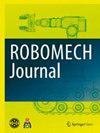用于传统液压挖掘机远程操作的改装机器人螺旋模型开发
IF 1.7
Q3 INSTRUMENTS & INSTRUMENTATION
引用次数: 0
摘要
本文介绍了在一家新成立公司的机器人系统开发过程中应用螺旋模型的效果。该机器人系统的开发目的是远程控制一台传统的液压挖掘机,以提高操作人员在灾害应急修复中的安全性。开发过程中的问题是如何定义需求,以及如何将新进入公司的实用系统集成到实际环境中。小型公司新进入市场的制约因素有以下三点。(1) 缺乏行业知识和数据来确定需求 (2) 缺乏现场环境和机器来进行调查和测试 (3) 缺乏机器人开发经验 为了解决这些制约因素下的问题,螺旋模型将基于原型的开发分为 4 个步骤,并重复这一系列过程。通过这种方法,一步步明确了机器人的必要功能和性能,并构建了一个在真实环境中具有鲁棒性的系统。因此,该机器人系统已成功用于山体滑坡造成的紧急灾后恢复任务和福岛第一核电站的废墟清理工作,减轻了操作人员的精神和体力负担。本文章由计算机程序翻译,如有差异,请以英文原文为准。
Spiral model development of retrofitted robot for tele-operation of conventional hydraulic excavator
This paper describes the effect of applying spiral model to the development process of robot system for a new entrant company. The robot system was developed to remotely control a conventional hydraulic excavator in order to improve the safety of operators in disaster emergency restoration. The issues of development are the definition of requirements and integration for a practical system in a real environment by a new entrant company. The constraints to the new entry of smaller companies are the following three points. (1) Lack of industry knowledge and data to define requirements (2) Lack of on-site environment and machinery for investigation and testing (3) Lack of experience in robot development To solve the problems under these constraints, the spiral model divides the development based on the prototype into 4-steps, and repeats this series of processes. This method was applied to clarify the necessary functions and performance of the robot step by step, and to construct a system with robustness in a real environment. As a result, this robot system has been successfully utilized in emergency disaster recovery tasks due to landslides, and removing debris in the Fukushima Daiichi Nuclear Power Plant, reducing the mental and physical burden on the operators.
求助全文
通过发布文献求助,成功后即可免费获取论文全文。
去求助
来源期刊

ROBOMECH Journal
Mathematics-Control and Optimization
CiteScore
3.20
自引率
7.10%
发文量
21
审稿时长
13 weeks
期刊介绍:
ROBOMECH Journal focuses on advanced technologies and practical applications in the field of Robotics and Mechatronics. This field is driven by the steadily growing research, development and consumer demand for robots and systems. Advanced robots have been working in medical and hazardous environments, such as space and the deep sea as well as in the manufacturing environment. The scope of the journal includes but is not limited to: 1. Modeling and design 2. System integration 3. Actuators and sensors 4. Intelligent control 5. Artificial intelligence 6. Machine learning 7. Robotics 8. Manufacturing 9. Motion control 10. Vibration and noise control 11. Micro/nano devices and optoelectronics systems 12. Automotive systems 13. Applications for extreme and/or hazardous environments 14. Other applications
 求助内容:
求助内容: 应助结果提醒方式:
应助结果提醒方式:


